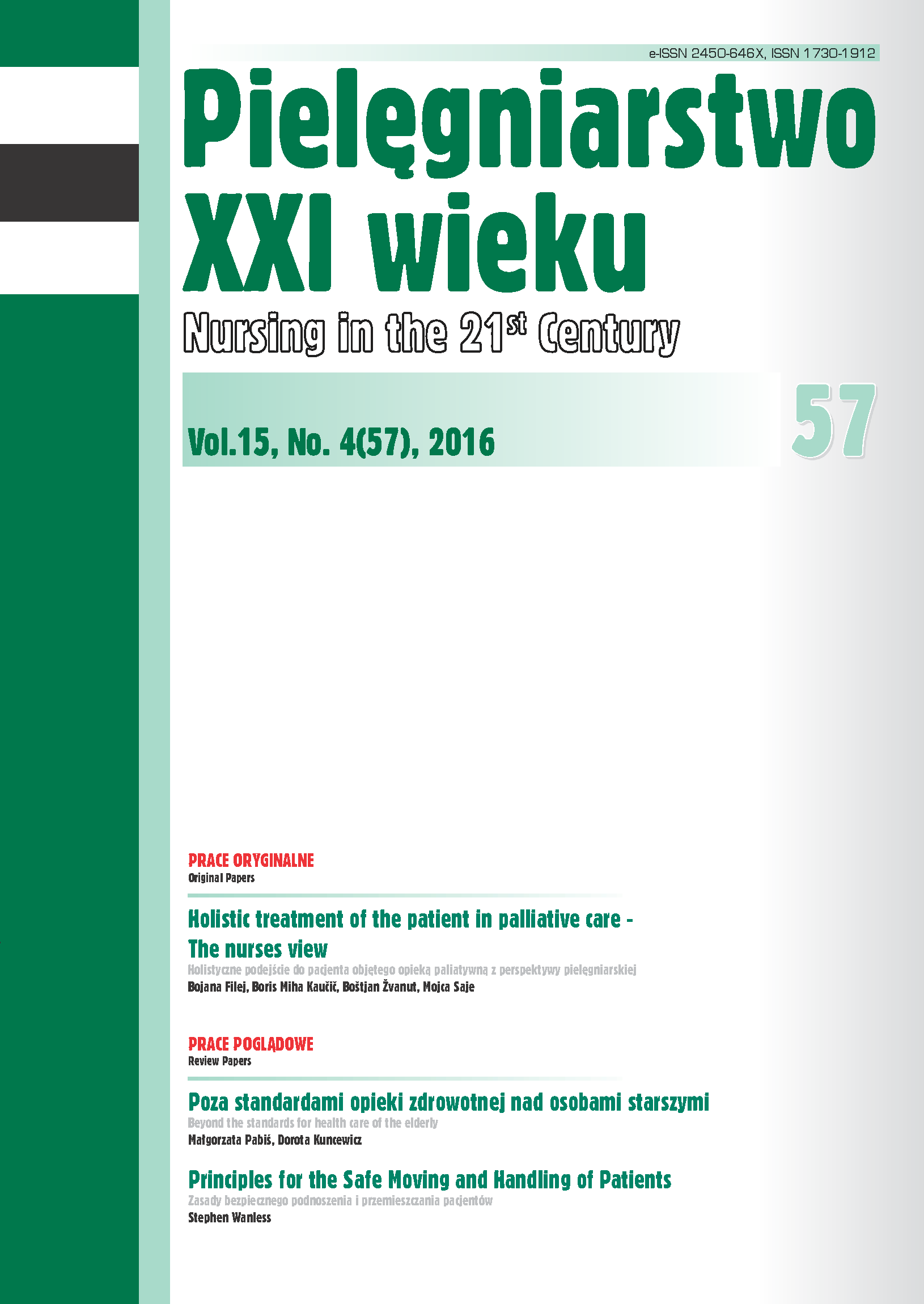Polska adaptacja Iowa Satisfaction with Anesthesia Scale
DOI:
https://doi.org/10.1515/pielxxiw-2016-0034Słowa kluczowe:
badania walidacyjne, anestezjologia, chirurgia szczękowo-twarzowa, opieka pielegniarskaAbstrakt
POLSKA ADAPTACJA IOWA SATISFACTION WITH ANESTHESIA SCALE
Wprowadzenie. Praca prezentuje adaptację of the Iowa Satisfaction with Anesthesia Scale do warunków polskich szpitali.
Materiał i metody. Proces adaptacji kulturowej Iowa Satisfaction with Anesthesia Scale podzielono na trzy etapy. Pierwszy etap polegał na opracowaniu polskiej wersji ISAS. W etapie drugim zastosowano polską wersje ISAS w grupie pacjentów z rozpoznanym urazem szczękow- twarzowym, poddanych zabiegowi operacyjnemu. W etapie trzecim oceniono własności psychometryczne polskiej wersji ISAS.
Wyniki. Analizie poddano 195 poprawnie wypełnionych kwestionariuszy polskiej wersji ISAS zebrane od pacjentów oddziału klinicznego chirurgii Klinicznego Oddziału Chirurgii Szczękowo-Twarzowej operowanych w znieczuleniu ogólnym z powodu urazu szczękowo-twarzowego. Średni wynik oceny zadowolenia ze znieczulenia w badanej populacji wynosił 0,77 (skali od -3 do +3) M=2, SD=2,41. Współczynnik Alfa Cronbacha obliczony dla 11 pozycji testowych wynosi 0,598. Zwiększenie wartości współczynnika Alfa Cronbacha jest możliwe w przypadku wyeliminowania pozycji testowej pytania nr 1: Wymiotowałem lub czułem, że będę wymiotował ( maksymalnie – 0,601). Wszystkie pozycje skali miały istotny wpływ na jej wynik ogólny ( p=0.0001).
Wnioski. Polska wersja Iowa Satisfaction with Anesthesia Scale spełnia wybrane kryteria równoważności psychometrycznej z wersją oryginalną.Konieczne są dalsze badania z użyciem polskiej wersji ISAS , aby zapewnić ciągłą weryfikację rzetelności i trafności narzędzia badawczego.
Bibliografia
1. Wanyura H. Urazy szkieletu czaszkotwarzowego. Kryst L. (red.). Chirurgia Szczękowo-twarzowa. Warszawa: PZWL; 2007.
2. Wołowicka L, Dyk D. Anestezjologia i intensywna terapia. Klinika i pielęgniarstwo. Warszawa: PZWL, 2008.
3. Paleczny J, Łoniewska-Paleczny E, Pysz M, Hura G. Porównanie zastosowania piersiowej blokady przykręgowej i znieczulenia ogólnego w chirurgii gruczołu piersiowego. Anestezjologia Intensywna Terapia. 2005; 37: 12-16.
4. Dexter F, Aker J, Wright W. Development of a Measure of Patient Satisfaction with Monitored Anesthesia Satisfaction with Anesthesia Scale. Anesthesia Analgesia. 1997; 87(4): 865-873.
5. Fung D, Marsha M. What Determines Patient Satisfaction with Cataract Care Under Topical Local Anesthesia and Monitored sedation In a Community Hospital Setting. Anesthesia Analgesia. 2005; 100: 1644-1650.
6. Cohen M, Duncan P, Pope W, et al. The Canadian four-centre study of anesthetic outcomes. II. Can outcomes be used to assess the quality of anesthesia care? Canadian Journal of Anesthesia. 1992; 5: 430-439.
7. Eagle CJ, Davies JM. Current models of „quality”: an introduction for anesthetists. Canadian Journal of Anesthesia. 1993; 9: 851-862.
8. Pagenkopf D, Davies JM, Bahan M, et al. A complementary approach to outcome analysis in the parturient. International Journal of Health Care Quality Assurance. 1991;4:241-245.
9. Duncan P. Quality: a job well done!. Canadian Journal of Anesthesia. 1993; 9: 813- 815.
10. Orkin F, Cohen M, Duncan P. The quest for meaningful outcomes. Anesthesiology. 1993; 3: 417-422.
11. Meakin R, Weinman J. The Medical interview Satisfaction scale` (MISS-21) adapter for British general Practice. Family Practice. 2002; 19: 257-263.
12. Fleisher L.A, Mark L. Disseminating information using an anesthesiology Consultant report: impast on patient perceptions of quality of care. Journal of Clinical Anesthesia. 1999; 11(5): 380-385.
13. Pascal A. Development and Validation of a Perioperative Satisfaction Questionnaire. Anesthesiology. 2005; 102: 1116-1123.
14. Capuzzo M, Landi F, Bassani A, et al. Emotional and interpersonal factors are most important for patient satisfaction with anaesthesia. Acta Anaesthesiologica Scandinavica. 2005; 49: 735-742.
15. Schiff JH, Fornaschon AS. The Heidelberg Peri-anaesthetic Questionnaire-development of a New refined psychometric questionnaire. Anesthesia. 2008; 63: 1096-1104.
16. Dexter F, Candiotti K. Multicenter Assessment of the Iowa Satisfaction with Anesthesia Scale, an Instrument that Measures Patient Satisfaction with Monitored Anesthesia Care. Anesthesia Analgesia. 2011; 113(2): 364-368.
17. Wild D, Grave A, Marti M, et al. Principles of good practice for the translation and cultural adaptation process for patient-reported outcomes (PRO) measures: Report of the ISPOR Task Force for Translation and Cultural Adaptation. Value in Health. 2005; 8: 94–104.
18. Benatar-Haserfaty J, Monleon de la Calle, Sanz- Lopez A, Muriel Garcia A. Outpatient external dacryocystorhinostomy under regional anesthesia and sedation. Revista Española de Anestesiología y Reanimación. 2007; 54(1): 23-28.
19. Fung D, Cohen M, Stewart S, Davies A. Can the Iowa Satisfaction with Anesthesia Scale be used to measure patient satisfaction with cataract care under topical local anesthesia and monitored at a community hospital? Anesthesia Analgesia. 2005; 100(6): 1637-1643.
20. Jiménez GarcíaF, Del Real Capera A. Validation to Spanish of the Iowa Satisfaction with Anesthesia Scale (ISAS) for monitored anesthesia care in ophthalmic surgery. Rev Col Anesth. 2014; 42: 272-280.
Opublikowane
Numer
Dział
Licencja
Prawa autorskie (c) 2016 Autorzy

Praca jest udostępniana na licencji Creative Commons Attribution-NonCommercial-NoDerivatives 3.0 Unported License.




